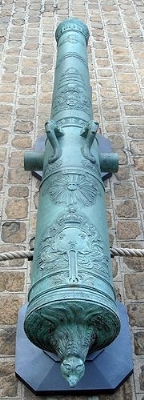
Canon de 12 de Vallière
Encyclopedia
The Canon de 12 de Vallière was a type of cannon designed by French officer Florent-Jean de Vallière
(1667–1759), Director-General of the Battalions and Schools of the Artillery.
Whereas numerous formats and designs had been in place in the French army, de Vallière standardized the French sizes in artillery pieces, by only allowing the production of 24, 12, 8 and 4 pound guns, mortars of 12 and 8 French inches, and stone-throwing mortars of 15 French inches. The 24-pdr was the largest caliber available to French artillery in this system.
The cannon used core drilling of the bore of cannons founded in one piece of bronze
, a method developed by Jean Maritz
, which allowed for much higher precision of the bore shape and surface, and therefore higher shooting efficiency.
As with other de Vallière guns, the 12-pdr was also highly decorated and contained numerous designs and inscriptions.
 Starting with the front part, the gun had a sight design at it extremity. Then followed the name of the gun (here Le Tonnerre). Then, a Latin phrase "Ultima Ratio Regum", initially introduced by Louis XIV, and a rather thorough description of the role of the gun: "The Last Argument of the King". Under that appears the name "Louis Charles de Bourbon, comte d'Eu, duc d'Aumale
Starting with the front part, the gun had a sight design at it extremity. Then followed the name of the gun (here Le Tonnerre). Then, a Latin phrase "Ultima Ratio Regum", initially introduced by Louis XIV, and a rather thorough description of the role of the gun: "The Last Argument of the King". Under that appears the name "Louis Charles de Bourbon, comte d'Eu, duc d'Aumale
", the Grand Maître de l'artillerie de France (Grand Master of the Artillery of France), followed by a royal emblem. In the middle of the cannon are trunnions, used to position the gun in place and elevate or depress it. On top of the trunnions are dolphin-shaped ornaments, which are used in lifting the gun.
", meaning that the King is "Not unequal to many (suns)". This is followed by the royal crest of the Bourbon dynasty. At the bottom of the gun, the location and date of manufacture are inscribed, and finally the name and title of the founder (in the example "Fondu par J. Martiz, Commissaire des Fontes"). The breech is decorated with an animal face showing the rating of the gun ("Bird" or "Rooster" for a 12-pounder).
Florent-Jean de Vallière
Florent-Jean de Vallière was a French artillery officer of the 18th century. He was lieutenant-general of the King's Armies. In 1726, de Vallière became Director-General of the Battalions and Schools of the Artillery....
(1667–1759), Director-General of the Battalions and Schools of the Artillery.
Development
The cannon was a result of the Royal Ordonnance of October 7, 1732, edicted to reorganize and standardize the King's artillery.Whereas numerous formats and designs had been in place in the French army, de Vallière standardized the French sizes in artillery pieces, by only allowing the production of 24, 12, 8 and 4 pound guns, mortars of 12 and 8 French inches, and stone-throwing mortars of 15 French inches. The 24-pdr was the largest caliber available to French artillery in this system.
The cannon used core drilling of the bore of cannons founded in one piece of bronze
Bronze
Bronze is a metal alloy consisting primarily of copper, usually with tin as the main additive. It is hard and brittle, and it was particularly significant in antiquity, so much so that the Bronze Age was named after the metal...
, a method developed by Jean Maritz
Jean Maritz
Jean Maritz , also Johan Maritz, was a Swiss inventor, born in Burgdorf, Canton of Bern, who moved to France, becoming "Commissaire des Fontes" at Strasbourg , and invented the vertical drilling machine, as well as the horizontal drilling machine for cannons in the 18th century...
, which allowed for much higher precision of the bore shape and surface, and therefore higher shooting efficiency.
As with other de Vallière guns, the 12-pdr was also highly decorated and contained numerous designs and inscriptions.
Front part

Louis-Charles, Count of Eu
Louis Charles de Bourbon, Count of Eu was a grandson of Louis XIV of France and his Maîtresse-en-titre Françoise-Athénaïs de Montespan. He was a member of the legitimised house of Bourbon du Maine...
", the Grand Maître de l'artillerie de France (Grand Master of the Artillery of France), followed by a royal emblem. In the middle of the cannon are trunnions, used to position the gun in place and elevate or depress it. On top of the trunnions are dolphin-shaped ornaments, which are used in lifting the gun.
Back part
The back part consists of, sometimes, an inscription showing the weight of the cannon ball (for example a "12" for a 12-pounder), followed by a Latin inscription "Nec pluribus imparNec pluribus impar
Nec pluribus impar is a Latin motto adopted by Louis XIV of France from 1658. It was often inscribed together with the symbol of the "Sun King": a head within rays of sunlight.-Meaning:...
", meaning that the King is "Not unequal to many (suns)". This is followed by the royal crest of the Bourbon dynasty. At the bottom of the gun, the location and date of manufacture are inscribed, and finally the name and title of the founder (in the example "Fondu par J. Martiz, Commissaire des Fontes"). The breech is decorated with an animal face showing the rating of the gun ("Bird" or "Rooster" for a 12-pounder).

